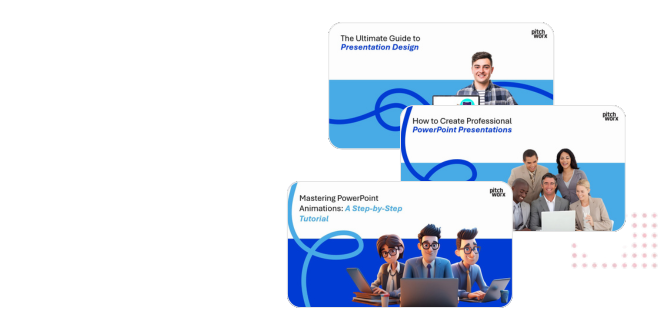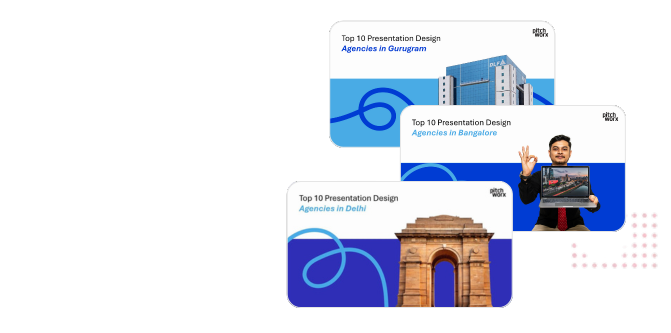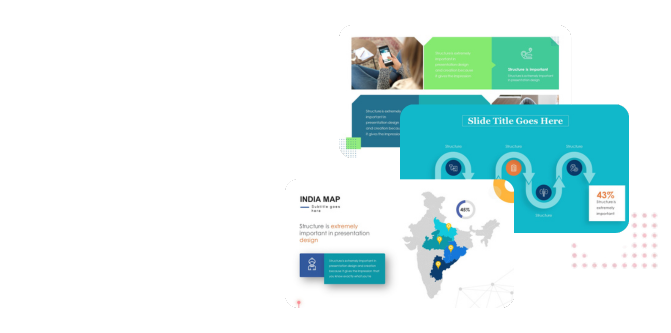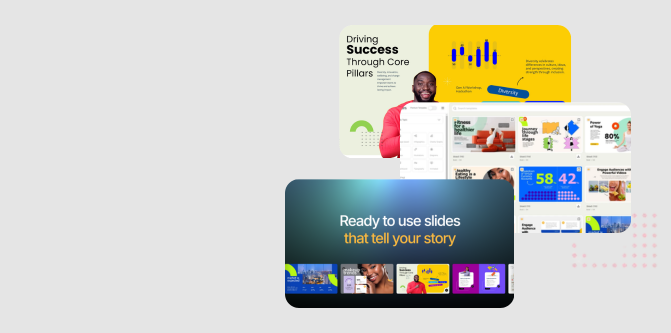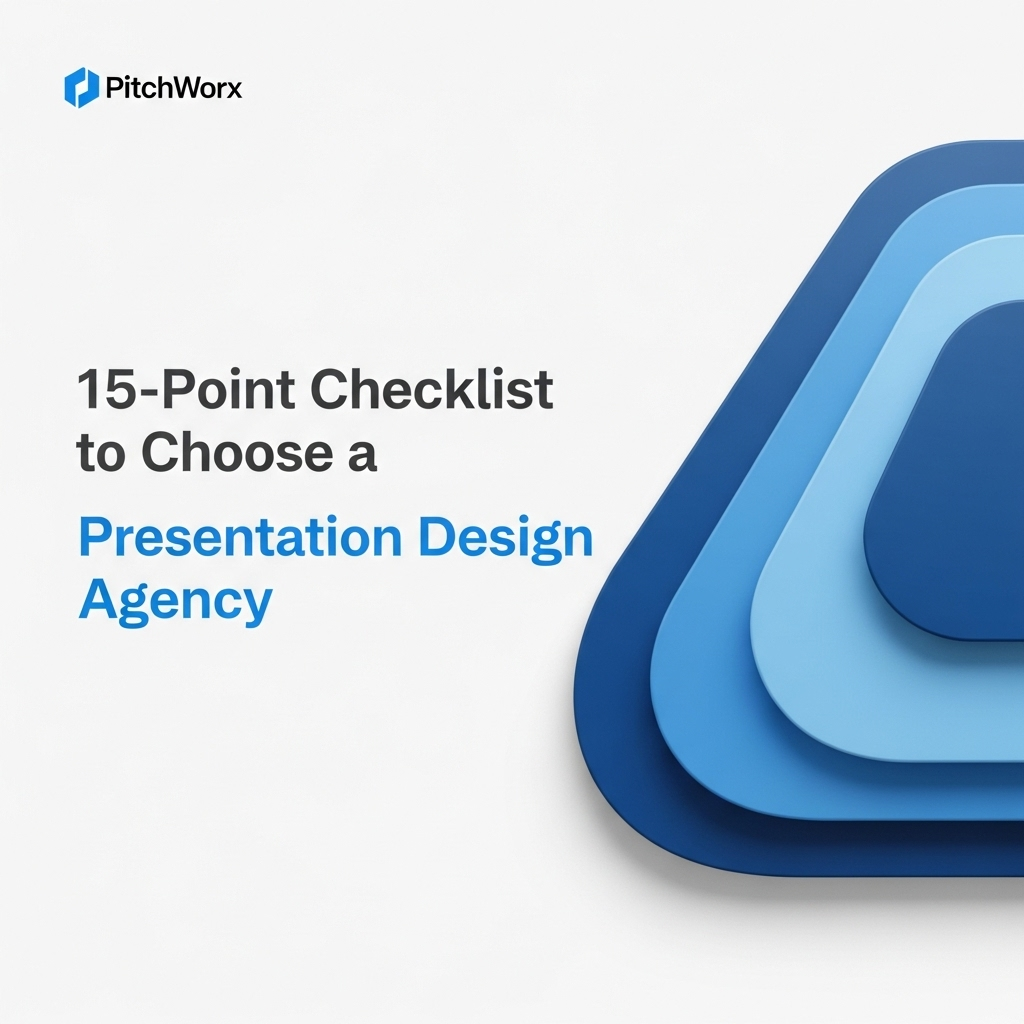The project is approved, the data is compiled, and the meeting is on the calendar. But the success of your next high-stakes initiative hinges on a single file: the presentation. In this moment, it’s not just a collection of slides; it’s the vehicle for a multi-million dollar decision, a critical company announcement, or a game-changing sales pitch. The pressure to deliver a message that is clear, compelling, and visually stunning is immense. This is often the point where leaders decide to move beyond in-house templates and choose a presentation design agency. But how do you select a true strategic partner from a sea of vendors?
Making the right choice is about more than just finding a team that can create beautiful slides. It’s about entrusting your narrative to experts who can amplify its impact and drive tangible results. A poorly chosen agency can lead to missed deadlines, misaligned messaging, and a final product that fails to connect with your audience. Conversely, the right agency becomes an extension of your team, a group of specialists dedicated to turning your ideas into a powerful communication tool. To help you navigate this crucial decision, we’re drawing on our 13+ years of experience to provide a comprehensive 15-point evaluation framework. With the help of our expert presentation design services, you can ensure your investment yields a powerful return.
Quick Answer
To choose a presentation design agency, evaluate their strategic capabilities, not just visual skills. A SHRM report highlights that poor communication can cost companies an average of $62.4 million per year, making an agency’s process critical. A successful choice depends on three factors:
- A deep portfolio review for relevant industry experience.
- A transparent and collaborative design process.
- Verifiable security credentials like ISO certification.
Table of Contents
- Why Partnering with an Agency is a Strategic Move
- The 15-Point Evaluation Framework
- Red Flags: Common Mistakes When Hiring an Agency
- Integrating the Agency into Your Workflow for Success
- Measuring the ROI of Professional Presentation Design
- Frequently Asked Questions
- Conclusion: From Vendor to Partner
Why Partnering with an Agency is a Strategic Move
Engaging a presentation design agency isn’t about outsourcing a task; it’s about insourcing specialized expertise that most companies don’t possess internally. Your marketing team is skilled at strategy, your sales team at closing deals, but a dedicated agency lives and breathes information design, narrative structure, and visual communication. The value extends far beyond aesthetics.
Effective communication is the bedrock of business success. Data from the Society for Human Resource Management’s (SHRM) report on communication highlights the staggering cost of getting it wrong. Their analysis of a survey covering 400 companies with 100,000 employees each found that inadequate communication could cost an average of $62.4 million per company annually, as cited in the The Cost of Poor Communications report. A professional agency ensures your most critical messages are delivered with clarity and impact, directly mitigating this risk.
Furthermore, a specialized agency brings an objective, outside perspective. They aren’t influenced by internal politics or historical baggage. Their sole focus is on the audience and the objective. This allows them to challenge assumptions, simplify complex ideas, and structure a narrative that resonates with external stakeholders, whether they are investors, clients, or partners.
About PitchWorx
With 13+ years of presentation design experience and 150,000+ slides created, PitchWorx is an ISO 27001 certified agency trusted by Fortune 500 companies across US, India, and UAE markets. Our expertise spans from high-stakes investor pitches to scalable corporate templates, ensuring every presentation is a strategic asset.
The 15-Point Evaluation Framework
To help you systematically evaluate potential partners, we’ve organized our 15-point checklist into four critical categories. Use this framework to move beyond subjective impressions and make a data-driven decision.
Part 1: Portfolio and Proven Expertise
An agency’s past work is the most direct evidence of its capabilities. However, a surface-level glance isn’t enough. You need to dig deeper to assess relevance and quality.
- 1. Industry Relevance: Does the agency have experience in your sector (e.g., fintech, healthcare, tech)? An agency that understands your industry’s nuances can grasp complex topics faster and create more relevant visuals.
- 2. Diversity of Work: Look for a range of presentation types. Have they worked on sales decks, investor pitches, corporate town halls, and technical presentations? This demonstrates versatility. When reviewing their past projects, check for both data-heavy slides and high-level conceptual ones.
- 3. Quality over Quantity: A small portfolio of outstanding, strategic work is more impressive than hundreds of mediocre slides. Assess the clarity of messaging, the quality of information design, and the overall narrative flow in their samples.
- 4. Verifiable Client Testimonials: Look for testimonials or case studies from recognizable companies. Are the testimonials specific, mentioning business results or process improvements, or are they generic?
Part 2: Process, Communication, and Collaboration
A great final product is the result of a great process. Understanding how an agency works is just as important as evaluating what it produces.
- 5. A Structured Discovery Process: Does their process begin with a deep dive into your goals, audience, and key messages? A top-tier agency will act like a consultant, asking probing questions to understand the “why” behind the presentation, not just the “what.”
- 6. Clear Communication Channels: How will you communicate with the team? Will you have a dedicated project manager? What are their standard response times? A clear communication protocol prevents delays and misunderstandings.
- 7. Defined Revision Rounds: Ask how they handle feedback and revisions. A transparent process with a set number of revision rounds included in the scope prevents scope creep and unexpected costs. At PitchWorx, we find that a structured two-to-three round process is most effective.
- 8. Content and Storytelling Support: Do they only design existing slides, or do they help refine your message, structure your narrative, and write compelling copy? Agencies that offer storytelling support, particularly when specialized in crafting compelling investor pitch decks, provide significantly more strategic value.
Part 3: Security, Professionalism, and Reliability
You’re trusting an agency with sensitive, often pre-launch, company information. Their professionalism and security posture are non-negotiable.
- 9. Data Security and Confidentiality: Ask about their data security protocols. Are they willing to sign a Non-Disclosure Agreement (NDA)? Certifications like ISO 27001 are the gold standard, demonstrating a formal commitment to information security management.
- 10. Scalability and Team Structure: Can the agency handle urgent requests or large projects? Understand the size and structure of their team. Do they rely on freelancers or have a dedicated in-house staff? This impacts consistency and availability.
- 11. Technical Proficiency: Ensure they are experts in the platform you use (PowerPoint, Google Slides, Keynote). Can they build robust, easy-to-edit templates for your team to use in the future? This is crucial for standardizing internal corporate decks.
Part 4: Value, Pricing, and Return on Investment
Finally, assess the commercial aspects of the partnership. The goal is to find the best value, not necessarily the lowest price.
- 12. Transparent Pricing Model: Is their pricing clear and easy to understand? Whether it’s per-project, per-slide, or a retainer model, you should know exactly what you’re paying for. Beware of hidden costs for things like stock imagery or revision rounds.
- 13. Focus on Outcomes, Not Outputs: During your initial conversations, does the agency talk about the number of slides they’ll deliver, or do they ask about the business outcome you want to achieve? True partners focus on helping you win the deal or secure the funding.
- 14. Post-Project Support: What happens after the project is delivered? Do they offer support for minor edits or provide training on how to use the new template? This can be crucial for long-term value.
- 15. Strategic Partnership Potential: Does this feel like a transactional vendor relationship or the beginning of a long-term partnership? An agency that invests time in understanding your brand and goals can become an invaluable asset, helping you drive conversions with high-impact sales presentations over time.
Red Flags: Common Mistakes When Hiring an Agency
Knowing what to look for is only half the battle. Recognizing warning signs can save you from a costly mistake. Our experience has shown a few key red flags that should give you pause:
- A “One-Size-Fits-All” Portfolio: If every presentation in their portfolio looks stylistically identical regardless of the client or industry, it suggests they apply a formula rather than developing a custom strategy for each project.
- Vague or No Process: If they can’t clearly articulate their step-by-step process from kickoff to delivery, it’s a sign of disorganization that will likely lead to project delays and frustration.
- Overemphasis on Speed and Low Cost: While efficiency is important, agencies that lead with “fastest turnaround” or “cheapest prices” are often competing on factors other than quality and strategic value. This can result in rushed work that misses the mark.
- Lack of Probing Questions: A great partner will challenge you. If an agency accepts your brief without asking deep questions about your audience, objectives, and core message, they are acting as an order-taker, not a strategic consultant.
| Aspect | Strategic Partner Mindset | Vendor Mindset (Red Flag) |
|---|---|---|
| Initial Questions | “What business outcome does this deck need to achieve?” | “How many slides do you need and when?” |
| Portfolio Focus | Shows diverse, custom solutions with case studies. | Shows repetitive styles and templates. |
| Pricing Structure | Value-based, tied to strategic involvement. | Purely transactional (per slide/hour). |
| Security | Proactively provides NDA and highlights certifications (ISO). | Vague on confidentiality; no formal security posture. |
Integrating the Agency into Your Workflow for Success
Once you’ve selected an agency, the work isn’t over. A successful partnership requires effective integration and collaboration. Treat the agency as an extension of your team from day one.
Designate a Single Point of Contact
To avoid conflicting feedback and miscommunication, assign one person from your team to be the primary liaison with the agency’s project manager. This individual should be empowered to consolidate internal feedback and make decisions.
Provide a Comprehensive Briefing
The more context you provide upfront, the better the outcome. Your initial brief should include not only the raw content but also your brand guidelines, information about the target audience, the context of the presentation (e.g., live event, email attachment), and clear objectives.
Trust Their Expertise
You hired an agency for their specialized skills. Be open to their suggestions, even if they challenge your initial ideas. A great agency will push back constructively to elevate the final product. They may suggest cutting content, reordering the narrative, or using a visual metaphor you hadn’t considered. This collaborative tension often produces the best results.
Measuring the ROI of Professional Presentation Design
Investing in professional design should yield a tangible return. While some benefits are qualitative (like enhanced brand perception), many can be measured. To justify the investment, work with the agency to define success metrics upfront.
For Sales Decks
Conversion Rate
Track the percentage of meetings that lead to a next step or a closed deal before and after implementing the new deck.
For Investor Pitches
Funding Success
The ultimate metric. Measure the success rate in securing meetings and, ultimately, investment.
For Internal Comms
Adoption Rate
If the agency creates a new corporate template, track its adoption rate across departments. Higher adoption means better brand consistency.
Beyond these hard metrics, consider the soft ROI. A professionally designed presentation saves your senior team countless hours, allowing them to focus on their core responsibilities. According to a Forbes analysis on brand consistency, presenting a brand consistently across all platforms can increase revenue by up to 23%. A high-quality presentation is a critical brand touchpoint that reinforces this consistency.
Related Services
Frequently Asked Questions
How much does it cost to hire a presentation design agency?
Costs vary widely based on scope, complexity, and the agency’s expertise. A simple slide refresh might cost a few hundred dollars, while a strategic, data-driven investor pitch deck can cost several thousand. Most reputable agencies provide custom quotes based on a detailed project brief rather than a fixed per-slide rate, focusing on the value and outcome.
What is the typical turnaround time for a presentation design project?
Turnaround time depends on the project’s complexity and the number of slides. A standard 15-20 slide presentation might take 5-10 business days, including discovery, design, and revision rounds. It is crucial to clarify timelines upfront, especially for time-sensitive projects. At PitchWorx, we establish a clear project calendar at kickoff to ensure alignment.
Should I provide the final content before the design process starts?
It’s best to provide at least a detailed outline or a draft of the content. However, the best agencies offer storytelling and content services. They can help you refine your narrative, cut unnecessary text, and structure the flow for maximum impact. A collaborative approach to content and design often yields the strongest results.
What’s the difference between a freelance designer and an agency?
A freelance designer is often a single individual focused purely on the visual design aspect. An agency typically provides a full team, including a project manager, strategist, copywriter, and multiple designers. This offers greater scalability, a more strategic process, built-in quality control, and better reliability for complex or high-stakes projects.
How important is industry-specific experience?
It is highly important. An agency with experience in your industry, such as healthcare or finance, will understand the specific compliance, terminology, and audience expectations. This reduces the learning curve, leads to more insightful design choices, and ensures the final product resonates authentically with your target audience.
What if my information is highly confidential?
This is a critical consideration. A professional agency must have robust confidentiality protocols. Always ask for them to sign a Non-Disclosure Agreement (NDA) before sharing any sensitive information. Furthermore, look for agencies with formal security certifications like ISO 27001, which demonstrates a verified commitment to protecting client data through established management systems.
Conclusion: From Vendor to Partner
To choose a presentation design agency is to choose a communications partner. The decision transcends a simple search for slide designers; it’s an investment in clarity, persuasion, and strategic storytelling. By using the 15-point framework to evaluate potential agencies based on their portfolio, process, professionalism, and value, you can move beyond aesthetics and identify a team that will truly elevate your message. The right partner doesn’t just deliver a file; they deliver confidence, amplify your narrative, and contribute directly to your business goals.
Your next presentation is an opportunity. By selecting an agency that understands this, you equip your team with a powerful tool designed not just to be seen, but to drive action.
Ready to elevate your presentations? Our presentation design services help businesses across global markets. View our case studies to see how we transform ideas into compelling visual stories.




